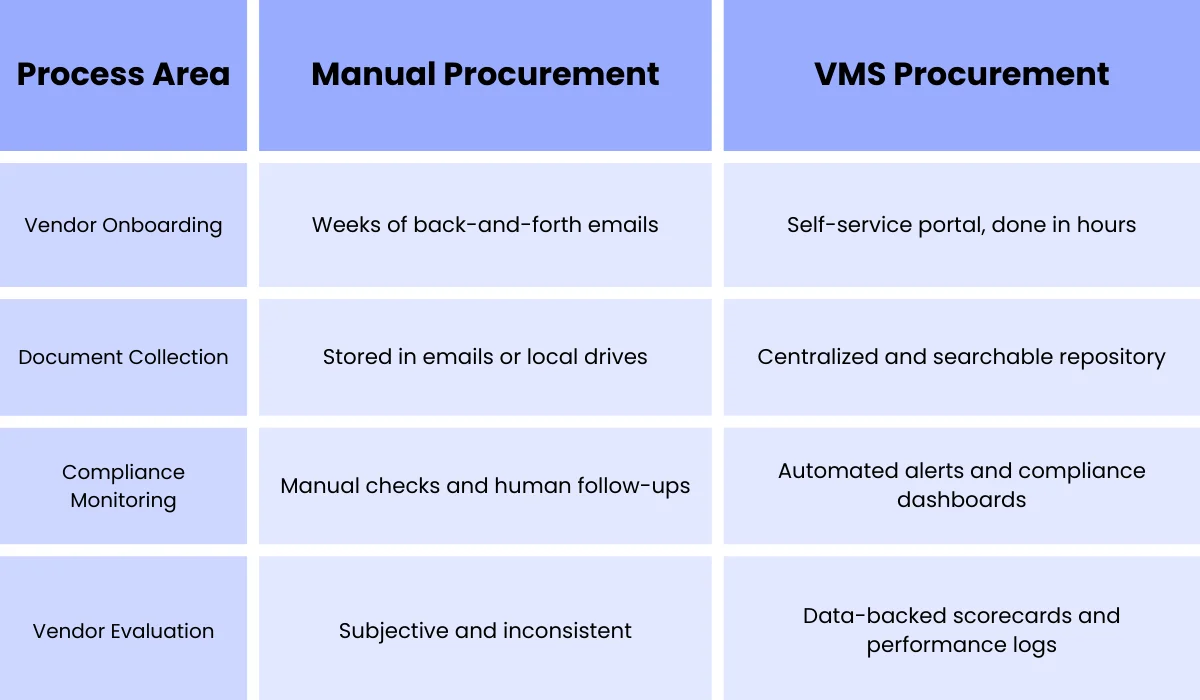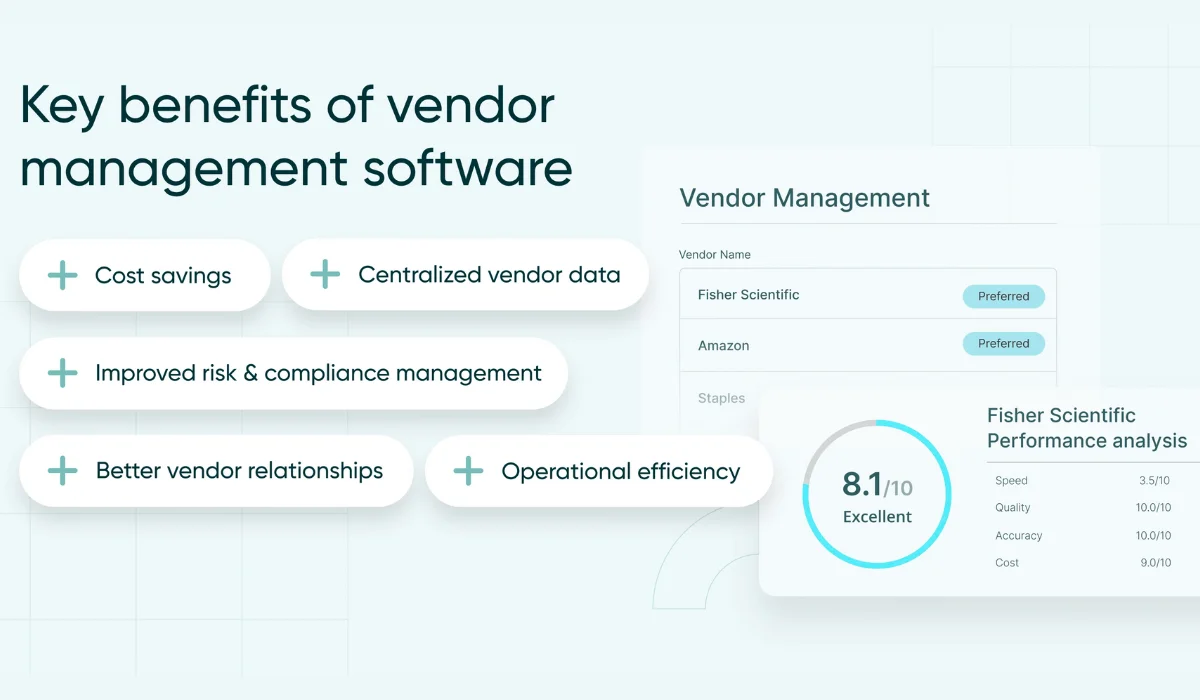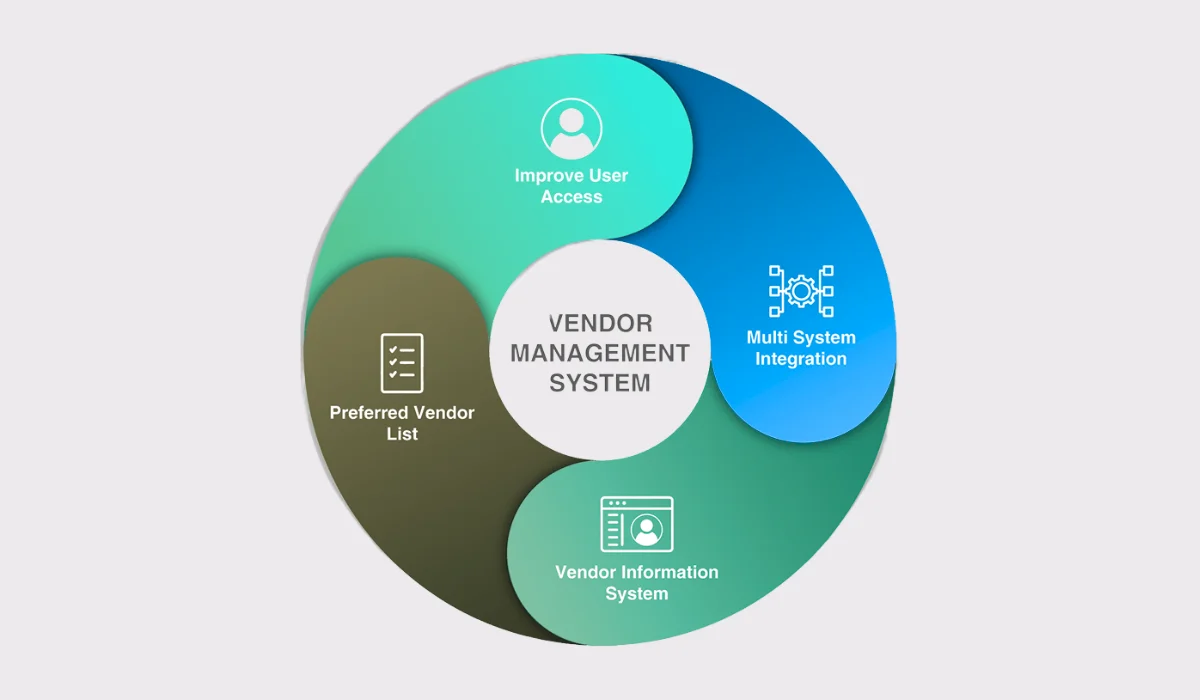Your business’s efficiency depends on what you have. The right tools, resources, and systems, are all important to keep your business growing. Equally important is how easily you can procure them and who your vendors are. They are an important asset for your business that you cannot ignore. Building strong, reliable relationships with them is crucial for keeping production on track and running daily operations seamlessly.
However, if spreadsheets are your organizer, you might not gain what your competitors get. They are turning to advanced, cloud-based vendor management systems (VMS), which reduce manual tasks and improve efficiency. These systems are a valuable strategic asset for your business, not only for procurement but also for strong vendor relationships.
What is a Vendor Management Tool?
A Vendor Management System (VMS) is a digital solution built to help you manage the extended workforce, whether that includes freelance contractors, temporary staff, or third-party service providers. This centralized platform brings together all the moving parts of vendor management, from finding and onboarding new partners to monitoring their performance and smoothly wrapping up engagements.
The typical VMS includes features like:
- Vendor registration and onboarding
- Document management and verification
- Compliance and certification tracking
- Performance analytics and scorecards
- Contract lifecycle management
- Invoice tracking and payment workflows
- Audit trails for approvals and changes
- Role-based access and security features
Unlike spreadsheets or disconnected tools, a VMS provides an integrated environment where vendor data is visible, accessible, and actionable across departments.
Also Read: How Does a Vendor Management System Help You Save Money and Manage Quotes?
What Procurement Challenges a VMS Solves For Your Business?

The pressure to deliver more with less is a mounting challenge in procurement. The daily grind leaves little room for strategy or innovation, from chasing approvals to tracking down documents across departments. There are more such challenges, such as:
1. Disorganized Vendor Data
Procurement teams often waste hours just trying to find the latest version of a contract or W-9 form. Vendor data is scattered across emails, Excel sheets, and cloud folders without a centralized system. When vendor data is scattered across different tools or stored manually, it often results in duplicate records, outdated versions, and time-consuming tracking efforts.
2. Manual Approval Processes
Every purchase request that requires five signatures and goes through three departments slows down your business. Traditional procurement relies heavily on email threads and verbal reminders. Approvals get delayed, documentation gets lost, and urgent needs become bottlenecks.
3. Compliance Blind Spots
Compliance isn’t optional when managing multiple vendors across regions with different legal standards, it’s critical. You risk hefty fines and reputational damage without a real-time system to flag expired certificates or missing documentation.
4. Poor Spend Visibility
One of the biggest frustrations for finance teams is not knowing how much is spent, with whom, and why. Fragmented systems make it nearly impossible to get a consolidated view of vendor-related spending, which stifles strategic planning.
5. Reactive Risk Management
In manual systems, risk is identified only after an issue occurs. Late deliveries, payment disputes, or non-compliant vendors are often addressed too late, resulting in project delays and financial loss.
The Benefits of Vendor Management Systems

As vendor networks continue to grow in complexity, managing vendor data effectively becomes increasingly crucial. The best vendor data management software is a reliable backbone for processing and storing this data, offering a high-level overview of vendor activities. Instead of endlessly searching through spreadsheets or chasing down emails, a VMS centralizes everything, saving you time and minimizing the potential for human error. Here are some key benefits of adopting a VMS:
- Streamlined Vendor Procurement: A VMS automates many of the routine tasks associated with managing vendors, from audits to compliance checks. Reducing manual work alleviates the pressure on your procurement team and ensures that data is consistent and accurate. A VMS helps businesses reduce operational costs and speed up vendor engagement processes by automating key stages like onboarding and offboarding.
- Actionable Insights for Better Decision-Making: A VMS gives you access to accurate and comprehensive real-time data. This data-driven approach makes it easier to track spending, analyze vendor performance, and forecast future costs. With this predictive analysis, you can make smarter decisions when selecting vendors and adjusting your procurement strategy.
- Better Communication: Say goodbye to the chaos of back-and-forth emails and missed phone calls. A VMS creates a shared space where all communication is organized, direct, and easy to follow. Linking discussions directly to documents creates a clearer, more organized way to track and resolve issues.
- Ensured Compliance: Compliance management can be a headache when vendor data is spread across different folders or systems. With a VMS, you have complete visibility into vendor performance and can easily monitor adherence to regulations and contractual agreements. This centralized approach simplifies audits, ensuring your vendors stay compliant without constantly searching for paperwork.
Also Read: Beyond Features: How to Choose the Best Vendor Data Management Software
How Your New Vendor Management System Should Be?

When buying a VMS, prioritize features that align with real procurement pain points:
Cloud-Based and Scalable
Your VMS should be accessible anytime, anywhere. Cloud-based platforms offer secure data storage, minimal maintenance, and real-time updates.
Custom Workflows and Approvals
Top-tier systems let you create rule-based workflows tailored to your internal processes. Whether multi-level approvals or automatic routing based on vendor type, custom workflows reduce human error and delay.
ERP and Third-Party Integrations
Procurement doesn’t happen in a vacuum. Look for a VMS that integrates with your ERP, accounting software, and sourcing platforms. This ensures consistent data flow and streamlines the procure-to-pay cycle.
Advanced Reporting and Dashboards
Basic data isn’t enough. You need slice-and-dice reporting, predictive analytics, and customizable dashboards that give different teams the insights they need when they need them.
AI-Powered Risk Intelligence
Leading VMS platforms use artificial intelligence to analyze vendor behavior, flag anomalies, and predict potential risks. That means your procurement team can act before you fall into the hands of the wrong vendor.
User-Friendly Interface
Procurement tools often suffer from poor adoption due to clunky interfaces. Choose a VMS with an intuitive design, mobile access, and minimal training requirements.
Conclusion
Procurement shouldn’t be a maze of paperwork, guesswork, and frustration. A vendor management system provides modern businesses the clarity and control to make procurement strategic rather than reactive.
Ready to take control of your vendor relationships? Discover how our VMS can simplify your procurement processes, enhance visibility, and drive better results. [Book a demo today].





